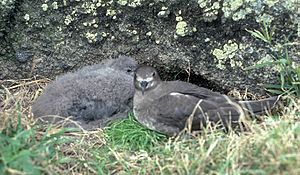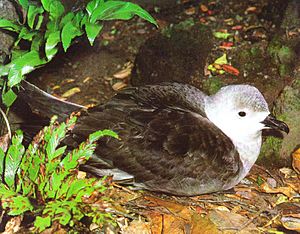Kermadec petrel facts for kids
Quick facts for kids Kermadec petrel |
|
|---|---|
 |
|
| Chick and parent, Meyer Island, 1970s | |
| Conservation status | |
| Scientific classification | |
| Genus: |
Pterodroma
|
| Species: |
neglecta
|
The Kermadec petrel (Pterodroma neglecta) is a type of seabird that belongs to the gadfly petrel family. These birds are known for their fast, darting flight over the ocean. The Kermadec petrel is about 38 centimeters (15 inches) long. Its wings can spread out to about 100 centimeters (39 inches) wide.
What's cool about them is that they can look quite different from each other! Some are light-colored, some are dark, and some are in between. This is called being polymorphic, meaning they have different color forms. They mostly eat squid, fish, and other small creatures they find in the sea.
Where They Live
Kermadec petrels live and breed in the Pacific Ocean. You can find them from Lord Howe Island all the way to the Juan Fernández Islands.
They have a small group of less than 100 birds that breed on Ball's Pyramid. This is a very tall and narrow rock island near Lord Howe Island. In the past, more of these birds used to breed on the main islands nearby. However, that is not common today.
Not much is known about their breeding habits at Balls Pyramid. But they usually nest there in the late summer. This time matches when other birds in the Kermadec Islands also breed. A larger type of Kermadec petrel also breeds on Round Island, which is off the coast of Mauritius. Sometimes, these birds might even breed with the Trindade petrel there.
Sometimes, a Kermadec petrel might fly far from its usual home. This is called being a vagrant. They have been seen as vagrants in Hawaii, Australia, and New Zealand.
Reproduction and Life Cycle
Kermadec petrels are monogamous, which means they stay with one partner. Each year, they raise just one chick. This young bird becomes independent and can fly on its own after about 100 to 130 days.
These petrels are a bit unusual because their breeding times can vary a lot. Different groups of Kermadec petrels might start nesting at different times. Some colonies nest from October to February, while others might nest from February to March.
See also
 In Spanish: Petrel de Kermadec para niños
In Spanish: Petrel de Kermadec para niños



